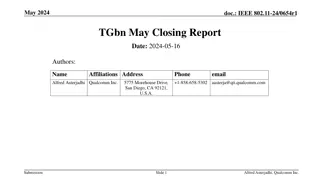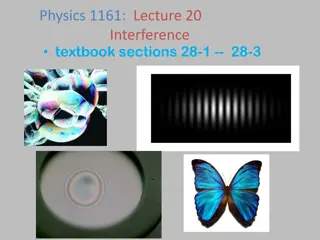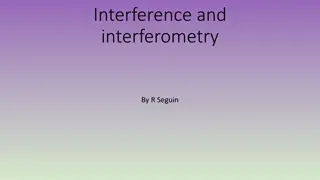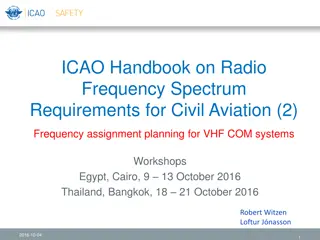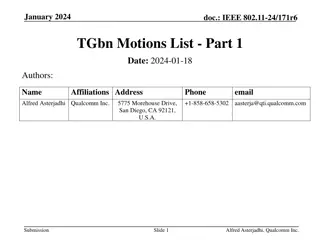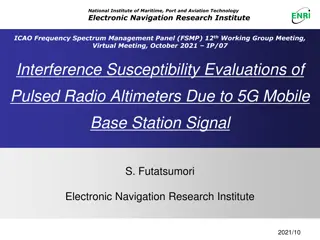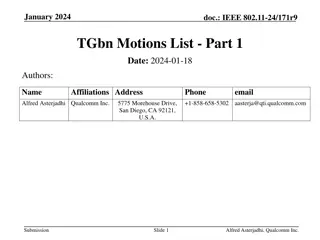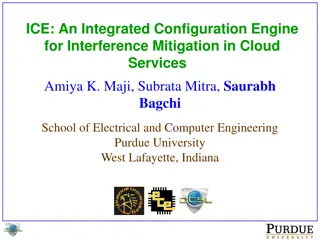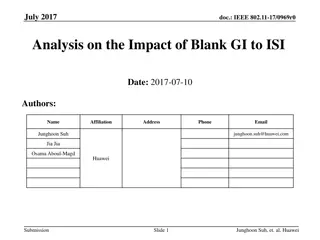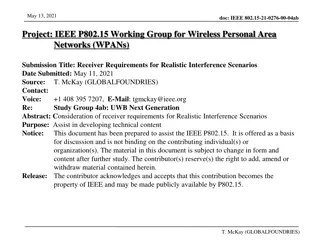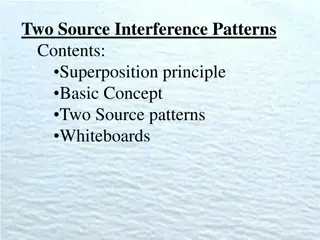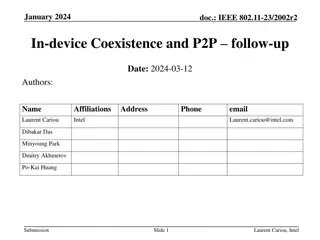
Supporting Rx Interference Mitigation in TGbn - July 2024 IEEE Paper
In this July 2024 IEEE document, authors from Huawei address the challenge of interference mitigation in WLAN technologies. They propose a novel transmission scheme involving Interference Mitigation (IM) pilots within the data field to enable Rx Beamforming/interference mitigation at the receiver side. The document emphasizes the importance of interference mitigation for improved performance and reduced latency in achieving ultra-high reliability in TGbn. Various interference sources are discussed, and the effectiveness of coping mechanisms like Receive Beamforming is highlighted. The proposed method involves transmitting known pilots interlaced with data to assist in identifying and mitigating interference of any bandwidth.
Download Presentation

Please find below an Image/Link to download the presentation.
The content on the website is provided AS IS for your information and personal use only. It may not be sold, licensed, or shared on other websites without obtaining consent from the author. If you encounter any issues during the download, it is possible that the publisher has removed the file from their server.
You are allowed to download the files provided on this website for personal or commercial use, subject to the condition that they are used lawfully. All files are the property of their respective owners.
The content on the website is provided AS IS for your information and personal use only. It may not be sold, licensed, or shared on other websites without obtaining consent from the author.
E N D
Presentation Transcript
July 2024 doc.: IEEE 802.11-24/1264r0 Supporting Rx Interference Mitigation in TGbn Date: July 9, 2024 Authors: Name Shimi Shilo Affiliations email shimi.shilo@huawei.com Rani Keren Ezer Melzer Huawei Yaron Ben Arie Oded Redlich Doron Ezri Slide 1 Shimi Shilo et al., Huawei
July 2024 doc.: IEEE 802.11-24/1264r0 Introduction In previous contributions [1-5] we proposed a new transmission scheme, where Interference Mitigation (IM) pilots are inserted within the data field, thereby enabling Rx Beamforming/interference mitigation at the receiver side Mitigation of interference can result in improved performance and reduced latency, thus contributing to the ultra high reliability goal of TGbn In this contribution we summarize all important aspects, and suggest that TGbn will support an interference mitigation mode in order to reach this ultra high-reliability goal Slide 2 Shimi Shilo et al., Huawei
July 2024 doc.: IEEE 802.11-24/1264r0 The Ever-Present Problem of Interference Random, unexpected interference is one of the main reasons for the limited reliability in WLAN After all we re operating in unlicensed bands Interfering signals can occupy any bandwidth narrowband or wideband and can originate from several sources, for example: Any valid WLAN signal 3GPP transmissions in the unlicensed bands 2MHz narrowband-assisted UWB (as part of 802.15.4ab) Bluetooth (in the 2.4GHz band) Interference can rise at any time How has this problem of interference been addressed so far? Reducing MCS so that transmissions are more robust Retransmitting dropped packets Changing channel (e.g. to a channel with lower load) But these solutions are not suitable for an Ultra High Reliability technology Slide 3 Shimi Shilo et al., Huawei
July 2024 doc.: IEEE 802.11-24/1264r0 Coping with Interference - Receive Beamforming One classical approach to mitigating the interference, at the receiver side, is receive beamforming Various algorithms may be employed one example is MVDR given in [1] There are several benefits to this approach: It is a classical, well known approach (used in various technologies) Can be used to handle interference of any bandwidth, both narrowband and wideband Can be used to handle interference that rises anywhere within the PPDU assuming the receiver can monitor & identify it How would the receiver be able to identify and mitigate interference of any bandwidth and anywhere in time? We propose to transmit known pilots interlaced with the data as shown on the right; these pilots can be transmitted at fixed locations across all OFDM symbols Interference Mitigation Pilot Data Slide 4 Shimi Shilo et al., Huawei
July 2024 doc.: IEEE 802.11-24/1264r0 Interference Mitigation Simulation Results In order to evaluate the performance of this approach, we simulated the following: SIR = 10dB & 5dB, interference on entire BW (RU = 106-tone) Using MCS 6 (with ~20% IM pilots) 1Tx antenna, 4Rx antennas, 1 spatial stream, practical CHEST, TGn-D NLOS, LDPC Compared 2 receiver schemes: MRC (w/o and w/ interference) MVDR (with interference) In the presence of interference, whereas MRC suffers from an error floor (even with much lower MCS), Interference Mitigation (MVDR) enables operation with high MCS even at SIR = 5 dB! Slide 5 Shimi Shilo et al., Huawei
July 2024 doc.: IEEE 802.11-24/1264r0 Interference Mitigation Simulation Results We can also look at the Post-Processing SNR experienced at different receivers as a metric for the impact of applying interference mitigation Below is a comparison of the average PPSNR of MRC vs. interference mitigation (MVDR), with the following parameters: SNR is 20dB SIR is Normally distributed with 0.5dB STD around 5dB Whereas MRC yields very broad PPSNR around an erroneous mean, with IM we get a more consistent PPSNR around the true SNR value It also means that applying IM yields more reliable physical layer measurements Mean 7.9dB Mean 18.9dB Slide 6 Shimi Shilo et al., Huawei
July 2024 doc.: IEEE 802.11-24/1264r0 Interference Mitigation Simulation Results In order to further evaluate the impact of interference mitigation on the performance, we looked at the goodput comparing interference mitigation with MRC As shown in the figure, except at low SNR (where there is no reason to apply interference mitigation), the application of IM significantly improves the performance, up to (roughly) tripling the goodput In spite of the IM pilots overhead in the MVDR case, it enables a higher MCS and therefore much higher goodput Slide 7 Shimi Shilo et al., Huawei
July 2024 doc.: IEEE 802.11-24/1264r0 Identifying & Mitigating a Sudden Interference Interference begins We consider a PPDU where the interference begins after the 11th OFDM symbol Focusing on the 3 OFDM symbols before and after the interference rises, the figure below shows the effective post-equalization gain computed for each direction of arrival (DoA) We see that the maximum gain is attained at DoA 20 (the DoA of the desired signal) regardless of the interference However, immediately when the interference begins, a deep (~50dB) null is created around the 20 direction (the DoA of the interference) OFDM sym #13 OFDM sym #14 OFDM sym #10 OFDM sym #11 OFDM sym #12 OFDM sym #15 OFDM sym #16 OFDM sym #1 OFDM sym #2 OFDM sym #3 OFDM sym #4 OFDM sym #5 OFDM sym #6 OFDM sym #7 OFDM sym #8 OFDM sym #9 time Slide 8 Shimi Shilo et al., Huawei
July 2024 doc.: IEEE 802.11-24/1264r0 Link-Adaptation Perspective We also looked at the impact of interference mitigation on link adaptation; we assume each PPDU is interfered with probability ?? Without IM, link adaptation experiences a bad tradeoff between minimizing PER and maximizing goodput, which forces a penalty of either high PER or low goodput Either choose an MCS that utilizes the interference-free PPDUs and lose all interfered PPDUs (PER= ~ ??), or choose an MCS that utilizes the interfered PPDUs but only partially utilizes the interference-free PPDUs IM allows achieving maximum goodput and low PER with same MCS, similarly as in fixed channel conditions; this applies to all ?? values Improves goodputs given low PER constraint Helps fast convergence and robust steady-state for LA search algorithms Slide 9 Rani Keren et al., Huawei
July 2024 doc.: IEEE 802.11-24/1264r0 LA Perspective: IM enabled/disabled selection How is the selection between IM enabled and IM disabled carried out? Adaptive approach: Treat this selection as another dimension in the link adaptation TX parameters search space for goodput maximization along with: MCS, Nss, CP length, etc. Combine IM selection with the ACK guided trial-and-error based search. Example concepts: During IM disabled: Probe a higher MCS along with IM enabled. During IM enabled: Probe current MCS along with IM disabled. For trigger based uplink: The receiving AP can apply on-going and link independent monitoring of interference that can further serve the IM selection decision. This approach ensures IM pilots are invested only when they lead to higher goodput Fixed approach: If link reliability is more important than utilizing maximum throughput, IM enabled can be applied as a fixed configuration. Slide 10 Rani Keren et al., Huawei
July 2024 doc.: IEEE 802.11-24/1264r0 Impact on Tx Block Diagram Defining IM pilots in an RU, and the remaining data subcarriers as , the value of doesn t change: In addition to introducing IM pilots, duration/padding/LDPC parameters are based on instead of , SD IM N SD N N _ IM Pilots N = + N N N N , SD IM SD , _ SD SD IM IM Pilots Based on payload size and smaller number of tones ( ), determine: #OFDM Symbols Padding LDPC Parameters (e.g. #codewords, puncturing, LDPC extra symbol) N , SD IM Tx Block diagram is almost unchanged no impact on LDPC operation or tone mapping (using same ); applying LDPC Tone Mapping on data+IM Pilots yields IM Pilots which are spread almost evenly in frequency D TM Slide 11 Rani Keren et al., Huawei
July 2024 doc.: IEEE 802.11-24/1264r0 Additional Benefits Strengthening Spatial Reuse IM applied at the Rx side can be used to enhance SR performance; with SR an OBSS STA is allowed to transmit while there is an ongoing transmission in the BSS, but it limits its transmit power as a function of the OBSS PD threshold In other words, with SR an ongoing BSS transmitter allows an OBSS STA to transmit simultaneously such that it doesn t create too much interference at target BSS receiver However, the interference to the ongoing transmission is not fully controlled Using IM pilots, the ongoing transmission can ensure high reliability at its Rx side, in particular resilience to interference exactly the aim of SR OBSS STA can also use IM pilots to ensure high reliability at its own target receiver side Slide 12 Rani Keren et al., Huawei
July 2024 doc.: IEEE 802.11-24/1264r0 Additional Benefits Supporting Mobility Applying an Rx beamforming IM scheme can also handle mobility to some extent Suppose is a receiver channel estimate of the true channel with error as a result of channel time variation The received signal can be expressed as e s s s = + = + y h n h h n es h h h e h h = + h h e The term is referred to by the RX beamforming scheme as an interferer that should be mitigated This approach is suboptimal since the desired signal is partially mitigated. However, it is still much better than not handling mobility at all. Slide 13 Rani Keren et al., Huawei
July 2024 doc.: IEEE 802.11-24/1264r0 Past Q&A Q: How many IM pilots are needed? A: As shown in [2,3], the sweet-spot is around ~16-20% resources used for IM pilots Q: Can t we use the existing CFO pilots for interference mitigation? A: Since it is our aim to handle both wideband and narrowband int., and based on our simulation results (see previous Q), the existing CFO pilots are not sufficient Q: Why not use midambles (defined in 11ax) instead of IM pilots? A: As shown in [3], using midambles for interference mitigation yields an error floor assuming the interference can rise anywhere within the PPDU (i.e. between midambles, so that certain codewords fail decoding) Q: Wouldn t throughput be reduced due to the use of IM pilots? A: Link/rate adaptation would invoke IM only if it increases the throughput compared with no IM Q: How does a transmitter choose whether to employ IM pilots or not? A: The transmitter can let the Link/Rate-Adaptation mechanism choose automatically as we showed in [5]; alternatively, when interference is a major concern, the transmitter can choose to always employ IM pilots Slide 14 Shimi Shilo et al., Huawei
July 2024 doc.: IEEE 802.11-24/1264r0 Summary Interference is one of the major reasons for the limited reliability in the unlicensed bands used for WLAN In previous meetings we presented the concept of interference mitigation at the receiver side as a means to achieve ultra high reliability We focused on several different aspects, including the huge performance benefits in the presence of interference, the minimum impact on Tx design and how it would interact with rate/link-adaptation Given the aim of achieving ultra high reliability in TGbn, we think interference mitigation should be incorporated into the SFD Slide 15 Shimi Shilo et al., Huawei
July 2024 doc.: IEEE 802.11-24/1264r0 Straw Poll #1 Do you agree to add the following to the TGbn SFD? 11bn will define a mode that enables mitigating interference that rises within the data portion of the PPDU? Slide 16 Shimi Shilo et al., Huawei
July 2024 doc.: IEEE 802.11-24/1264r0 Straw Poll #2 Do you agree to add the following to the TGbn SFD? 11bn will define a mode with additional pilots used for interference mitigation Slide 17 Shimi Shilo et al., Huawei
July 2024 doc.: IEEE 802.11-24/1264r0 References [1] 11-23-1490r0: Physical Layer Reliability Improvements (Shimi Shilo et al) [2] 11-23-1943r1: Physical Layer Reliability Improvements Follow Up (Shimi Shilo et al) [3] 11-24-107r0: PHY Layer Interference Mitigation for Improved Reliability (Shimi Shilo et al) [4] 11-24-437r0: Interference Mitigation for Improved Reliability More Insights (Shimi Shilo et al) [5] 11-24-889r0: Interference Mitigation for Improved Reliability Link Adaptation Perspective (Rani Keren et al) Slide 18 Shimi Shilo et al., Huawei

